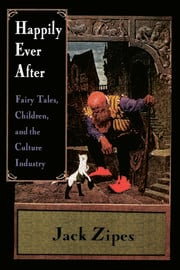 Chuck Lipsig wrote this review.
Chuck Lipsig wrote this review.
I am not, I suspect, the intended audience for Jack Zipes’s Happily Ever After: Fairy Tales, Children, and the Culture Industry. Zipes is a solidly on the political left, bemoaning the capitalist culture industry, especially Disney. I’m a pro-laissez faire celebrator of consumer culture and, specifically, a Disney fan. So when I say this is an excellent book, take it seriously.
Zipes’s thesis is that fairy tales play a major role in socializing children and adults. The first chapter, on the “Puss in Boots” story and variations, provides a fascinating case history of the development of such socialization. The second chapter similarly treats “Hansel and Gretel,” concentrating on how it justifies child abuse.
Zipes then pursues the line that Disney, in becoming the leading member of the culture industry and predominant purveyor of fairy tales in this culture is a major force in socializing children to consumer culture. He examines this with special attention to “Pinocchio” and “The Lion King.” He also discuss several other recent fairy tale productions — specifically the works of Jim Henson, Shelly Duvall, and Tom Davenport — that have to some extent subverted the culture industry’s telling of fairy tales.
In the final chapter, Zipes concludes that it is necessary for fairy tales to be recaptured by storytellers to create community values, especially among young children, that will combat the dominant free (or as Zipes writes, “free”) market culture.
The genius of Zipes is that Happily Ever After is written at two levels. Those who share Zipes’s political and cultural beliefs will find this a very rousing book, a book worth cheering along with. However, the veneer of political terminology does not get in the way of the information content and those who do not share the author’s beliefs will still find the book a fascinating study.
The clarity with which Zipes writes is demonstrated on the thankfully few occasions he quotes others’ scholarly writing. On “Puss in Boots,” Zipes quotes the following gobbledygook by Louis Marin: “[T]he cat is an operator of change: he articulates a spatial continuum that differentiates space by a temporal program or better strategy.” In contrast, Zipes’s own words are much clearer: “It is not only the manipulation of speech within the tale that outlines how man can succeed in society; it is in Perrault’s very writing of the text itself that generic prescriptions take hold, assume power, and become established models for reading and writing.” This is writing that academics of all political and philosophic stripes would do well to emulate.
Furthermore, Zipes is a fair person. He may have a dislike for Disney and its effects, but he is unwilling to burden them with charges of intentional evil and points out that Disney has generally been more interested in overcoming technical challenges in the design of their movies than in any specific agenda.
But every so often, Zipes does let his anti-Disneyism get the better of him. At one point he disparages the ending of “The Lion King,” with Simba and his mate presenting their cub to the adoring throng below. But he praises Jim Henson’s “The Frog Prince,” even though it ends with the prince and princess coronated, and having a child to carry on their royal line. He notes that “The Frog Prince” is more about friendship and family than upholding power structures, but a similar argument could be made for “The Lion King.”
Indeed, the only weak chapter is “Lion Kings and the Culture Industry,” which is less on fairy tales than on how society creates its own lion kings. It’s an angry chapter, less substantial than the rest of the book, and neither fits with nor measures up to the rest of the book. (Though it is interesting to speculate, based on this chapter, what Zipes, a professor at the University of Minnesota, makes of the election of former pro-wrestler Jesse “The Body” Ventura to governor of Minnesota.)
He also makes a few minor factual errors. Sesame Street did not go off the air in 1981; in fact it’s still running. Timon in “The Lion King” was not a gopher; he was a meercat. These, however, do not affect the substance of the book.
As a personal note, shortly after reading Zipes chapter on “Puss in Boots” I was struck by inspiration and wrote 50 pages of my own retelling of that fairy tale in three days. If I complete this story, I will have to thank Jack Zipes for the spark. If this book can inspire a laissez faire capitalist like me, it should inspire anyone. I recommend that every person with an interest in fairy tales and folklore read it.
(Routledge, 1998)
Interested in folklore concerning children? Check out the following reviews:
L. G. Burnett examines Henry Jenkins’ edited collection The Children’s Culture Reader
Jack B. Merry looks at Jane Yolen’s Touch Magic: Fantasy, Faerie and Folklore in the Literature of Childhood
Diane McDonough revels in discussing Alison Lurie’s Don’t Tell the Grown-Ups
Pamela Murray Winters digs Josepha Sherman and E.K.F. Weisskopf’s Greasy Grimy Gopher Guts: The Subversive Folklore of Childhood
